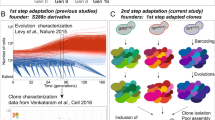Abstract
Adaptive mutations occur in nongrowing populations of cells to overcome strong, nonlethal selection conditions. Several models have been proposed for the molecular mechanism(s) for this phenomenon inEscherichia coli, but the mechanisms involved in adaptive mutagenesis in the yeastSaccharomyces cerevisiae are largely unknown. We present here a comparison of the mutational spectra of spontaneous and adaptive frameshift reversion events in yeast. In contrast to results fromE. coli, we find that the mutational spectrum of adaptive mutations inS. cerevisiae is not similar to that seen in mismatch repair defective cells, but rather resembles the spontaneous mutational events that occur during normal growth.
Similar content being viewed by others
References
Andersson D. I., Slechta E. S. and Roth J. R. 1998 Evidence that gene amplification underlies the adaptive mutability of the bacteriallac operon.Science 282, 1133–1135.
Baranowska H., Policinska Z. and Jachymczyk W. J. 1995 Effects of theCDC2 gene on adaptive mutation in the yeastSaccharomyces cerevisiae.Curr. Genet. 28, 521–525.
Boe L. 1990 Mechanism for induction of adaptive mutations inEscherichia coli.Mol. Microbiol. 4, 597–601.
Cairns J. and Foster P. L. 1991 Adaptive reversion of a frameshift mutation inEscherichia coli.Genetics 128, 695–701.
Cairns J., Overbaugh J. and Miller S. 1988 The origin of mutants.Nature 335, 142–145.
Cariello N. F., Piegorsch W. W., Adams W. T. and Skopek T. R. 1994 Computer program for the analysis of mutational spectra: application to p53 mutations.Carcinogenesis 15, 2281–2285.
Drake J. W. 1991 Spontaneous mutation.Annu. Rev. Genet. 25, 125–146.
Foster P. L. 1993 Adaptive mutation: the uses of adversity.Annu. Rev. Microbiol. 47, 467–504.
Foster P. L. 1997 Nonadaptive mutations occur on the F′ episome during adaptive mutation conditions inEscherichia coli.J. Bacteriol. 179, 1550–1554.
Foster P. L. 1998 Adaptive mutation: has the unicorn landed?Genetics 148, 1453–1459.
Foster P. L. and Cairns J. 1992 Mechanisms of directed mutation.Genetics 131, 783–789.
Foster P. L. and Trimarchi J. M. 1994 Adaptive reversion of a frameshift mutation inEscherichia coli by simple base deletions in homopolymeric runs.Science 265, 407–409.
Foster P. L. and Trimarchi J. M. 1995a Adaptive reversion of an episomal frameshift mutation inEscherichia coli requires conjugal functions but not actual conjugation.Proc. Natl. Acad. Sci. USA 92, 5487–5490.
Foster P. L. and Trimarchi J. M. 1995b Conjugation is not required for adaptive reversion of an episomal frameshift mutation inEscherichia coli.J. Bacteriol. 177, 6670–6671.
Foster P. L., Gudmundsson G., Trimarchi J. M., Cai H. and Goodman M. F. 1995 Proofreading-defective DNA polymerase III increases adaptive mutation inEscherichia coli.Proc. Natl. Acad. Sci. USA 92, 7951–7955.
Galitski T. and Roth J. R. 1995 Evidence that F plasmid transfer replication underlies apparent adaptive mutation.Science 268, 421–423.
Greene C. N. and Jinks-Robertson S. 1997 Frameshift intermediates in homopolymer runs are removed efficiently by yeast mismatch repair proteins.Mol. Cell. Biol. 17, 2844–2850.
Hall B. G. 1990 Spontaneous point mutations that occur more often when advantageous than when neutral.Genetics 126, 5–16.
Hall B. G. 1992 Selection-induced mutations occur in yeast.Proc. Natl. Acad. Sci. USA 89, 4300–4303.
Hall B. G. 1998 Adaptive mutagenesis: a process that generates almost exclusively beneficial mutations.Genetica 102–103, 109–125.
Harris R. S., Longerich S. and Rosenberg S. M. 1994 Recombination in adaptive mutation.Science 264, 258–260.
Harris R. S., Bull H. J. and Rosenberg S. M. 1997 A direct role for DNA polymerase III in adaptive reversion of a frameshift mutation inEscherichia coli.Mutat. Res. 375, 19–24.
Heidenreich E. and Wintersberger U. 1997 Starvation for a specific amino acid induces high frequencies of rho− mutants inSaccharomyces cerevisiae.Curr. Genet. 31, 408–413.
Heidenreich E. and Wintersberger U. 1998 Replication-dependent and selection-induced mutations in respiration-competent and respiration-deficient strains ofSaccharomyces cerevisiae.Mol. Gen. Genet. 260, 395–400.
Hoffman C. S. and Winston F. 1987 A ten-minute DNA preparation from yeast efficiently releases autonomous plasmids for transformation ofEscherichia coli.Gene 57, 267–272.
Kuzminov A. 1995 Collapse and repair of replication forks inEscherichia coli.Mol. Microbiol. 16, 373–384.
Lederberg J. and Lederberg E. M. 1952 Replica plating and indirect selection for bacterial mutants.J. Bacteriol. 63, 399–414.
Luria S. E. and Delbrück M. 1943 Mutations of bacteria from virus sensitivity to virus resistance.Genetics 28, 491–511.
Petes T. D., Malone R. E. and Symington L. S. 1991 Recombination in yeast. InThe molecular biology of the yeast Saccharomyces: genome dynamics, protein synthesis and energetics (ed. J. R. Broach, J. R. Pringle and E. W. Jones), pp. 407–521. Cold Spring Harbor Laboratory Press, Cold Spring Harbor.
Radicella J. P., Park P. U. and Fox M. S. 1995 Adaptive mutation inEscherichia coli: a role for conjugation.Science 268, 418–420.
Rosenberg S. M., Longerich S., Gee P. and Harris R. S. 1994 Adaptive mutation by deletions in small mononucleotide repeats.Science 265, 405–407.
Sherman F. 1991 Getting started with yeast.Meth. Enzymol. 194, 3–21.
Stahl F. W. 1988 A unicorn in the garden.Nature 335, 112–113.
Steele D. F. and Jinks-Robertson S. 1992 An examination of adaptive reversion inSaccharomyces cerevisiae.Genetics 132, 9–21.
Steele D. F. and Jinks-Robertson S. 1993 Time-dependent mitotic recombination inSaccharomyces cerevisiae.Curr. Genet. 23, 423–429.
Storchova Z., Rojas Gil A. P., Janderova B. and Vondrejs V. 1998 The involvement of theRAD6 gene in starvation-induced reverse mutation inSaccharomyces cerevisiae.Mol. Gen. Genet. 258, 546–552.
Torkelson J., Harris R. S., Lombardo M.-J., Nagendran J., Thulin C. and Rosenberg S. M. 1997 Genome-wide hypermutation in a subpopulation of stationary-phase cells underlies recombination-dependent adaptive mutation.EMBO J. 16, 3303–3311.
Author information
Authors and Affiliations
Corresponding author
Rights and permissions
About this article
Cite this article
Greene, C.N., Jinks-Robertson, S. Comparison of spontaneous and adaptive mutation spectra in yeast. J Genet 78, 51–55 (1999). https://doi.org/10.1007/BF02994703
Issue Date:
DOI: https://doi.org/10.1007/BF02994703




